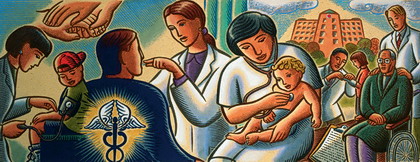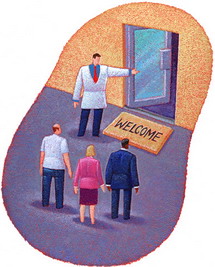Last year at this time, as word of the global economic meltdown was beginning to take hold, we saw the beginning of a decline in all aspects of purchasing, including the optional surgeries and tests in our hospitals. At the same time, as a member of several volunteer boards, we began to see declines in ticket sales that went as high as 20%. Later, we met with restaurateurs who indicated that their business was down between 10 and 20%, an amount that proved to be terminal for numerous marginal companies.

As the year proceeded, we saw hospitals make extensive cutbacks in employee education, travel, and marketing. This trend became the norm in the industry. The healthcare-related industries that seemed to hurt the most were those involved in construction and new equipment acquisition. One type of firm that did well was financial consulting groups, like SunStone Consulting, LLC , organizations that specialized in finding money that hospitals had already earned, but had either not been staffed deeply enough to pursue or that did not know the processes necessary to generate these funds.
For those of us in administrative consulting, the year has been interesting. Decision makers stepped back a little and waited to see where Obamacare was heading, to collect more cash in a society where “cash was definitely king,” and to cut back on new initiatives until things had settled down economically. These leaders watched the markets, looked at investment activities, counted revenue versus expense results, and generally became more conservative in their leadership approaches.
What’s on the horizon: There is an old saying that “He who looks into a crystal ball to predict the future will get crystal in his eye,” that is not far from truth. Are we completely out of the woods? Not by a long shot. Will there be additional taxes, additional expenditures that are not budgeted nationally? Yes, most assuredly, there will be, but are we certainly seeing more positive signs in virtually every economic indicator that would predict at least a somewhat more optimistic overall outlook.
Wall Street Journal: Pointing to renewed signs that the global slump is bottoming out, the International Monetary Fund on Wednesday upgraded its outlook for 2010 while slightly trimming this year’s forecast.
The overleveraged global financial system continues to cast a shadow over the economic outlook, however, and the fund urged policymakers not to become complacent about recent market improvements.
“Financial conditions have improved, as unprecedented policy intervention has reduced the risk of systemic collapse and expectations of economic recovery have risen,” the IMF said in its updating its outlook for the world economy and financial system. “Nonetheless, vulnerabilities remain and complacency…
 So, if we embrace those little rays of hope as a means of restarting the economic engines, if we visualize a better future for all of us, if we focus on the positive, at the very least we most likely will find a better parking space at the Mall!
So, if we embrace those little rays of hope as a means of restarting the economic engines, if we visualize a better future for all of us, if we focus on the positive, at the very least we most likely will find a better parking space at the Mall!
Happy Holidays and here’s knowing that 2010 will be a better year for everyone. (It wouldn’t take much!)



 The cost? In the big picture, the cost is not even a consideration. Your investment now is less than you can imagine, as your facilities grow, expand, and thrive. Besides:
The cost? In the big picture, the cost is not even a consideration. Your investment now is less than you can imagine, as your facilities grow, expand, and thrive. Besides:
 I have carefully observed organizations like Circuit City transition from model companies to bankrupt companies. They changed their incentive methodologies for their employees, stopped listening to them, and stood back and watched as those same employees undermined their sales by saying things like, “I don’t care what you buy. My check doesn’t change either way.”
I have carefully observed organizations like Circuit City transition from model companies to bankrupt companies. They changed their incentive methodologies for their employees, stopped listening to them, and stood back and watched as those same employees undermined their sales by saying things like, “I don’t care what you buy. My check doesn’t change either way.” Many organizations who embrace the various human dignity monikers such as
Many organizations who embrace the various human dignity monikers such as  Nicholas D. Kristof NYT photo
Nicholas D. Kristof NYT photo

 These are just a few of the very effective mechanism that can be introduced to create
These are just a few of the very effective mechanism that can be introduced to create 







